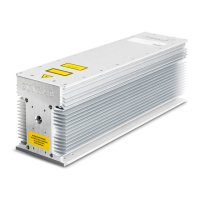maintenance/
troubleshooting
88
SYNRAD OEM v40 Operator’s Manual Version 4
Maintenance
3
Visually inspect Firestar’s exterior housing to ensure that all warning labels are present. Refer to v40
label locations in the Laser Safety chapter for label types and locations.
Storage/shipping
When preparing the laser for storage or shipping, remember to drain cooling water from water-cooled
lasers. In cold climates, any water left in the cooling system may freeze, which could damage internal
components. After draining thoroughly, use compressed shop air at less than 29 PSI (while wearing safety
glasses!) to remove any residual water. When nished, cap all connectors to prevent debris from entering
the cooling system.
When shipping SYNRAD lasers to another facility, we highly recommend that you ship the unit in its
original SYNRAD shipping container. If you no longer have the original shipping box and inserts, contact
SYNRAD Customer Service about purchasing replacement packaging. Refer to the Packaging instructions
drawing in the Technical Reference chapter or see the SYNRAD web site (www.synrad.com/manuals/
packaging.htm) for detailed instructions on properly packaging the laser for shipment.
Important Note: Failure to properly package the laser using a SYNRAD-supplied shipping box and
foam/cardboard inserts as shown in the Packaging Instructions may void the war-
ranty. Customers may incur additional repair charges for shipping damage caused by
improper packaging.
Cleaning optical components
Danger
serious
personal
injury
Ensure that DC power to the laser is turned o and locked out before
inspecting optical components in the beam path. Invisible CO
2
laser
radiation is emitted through the aperture. Corneal damage or blind-
ness may result from exposure to laser radiation.
Caution
possible
equipment
damage
Because of their smaller beam diameter, Firestar lasers have signi-
cantly higher power densities than previous SYNRAD lasers. This
means that even a small amount of contamination on the laser’s out-
put window (or on any optic in the beam path) can absorb enough
energy to damage the optic. Inspect the output window and other
beam delivery optics periodically for signs of contaminants and care-
fully clean as required. In dirty environments, purge laser optics using
ltered air or nitrogen to prevent vapor and debris from accumulating
on optical surfaces.

